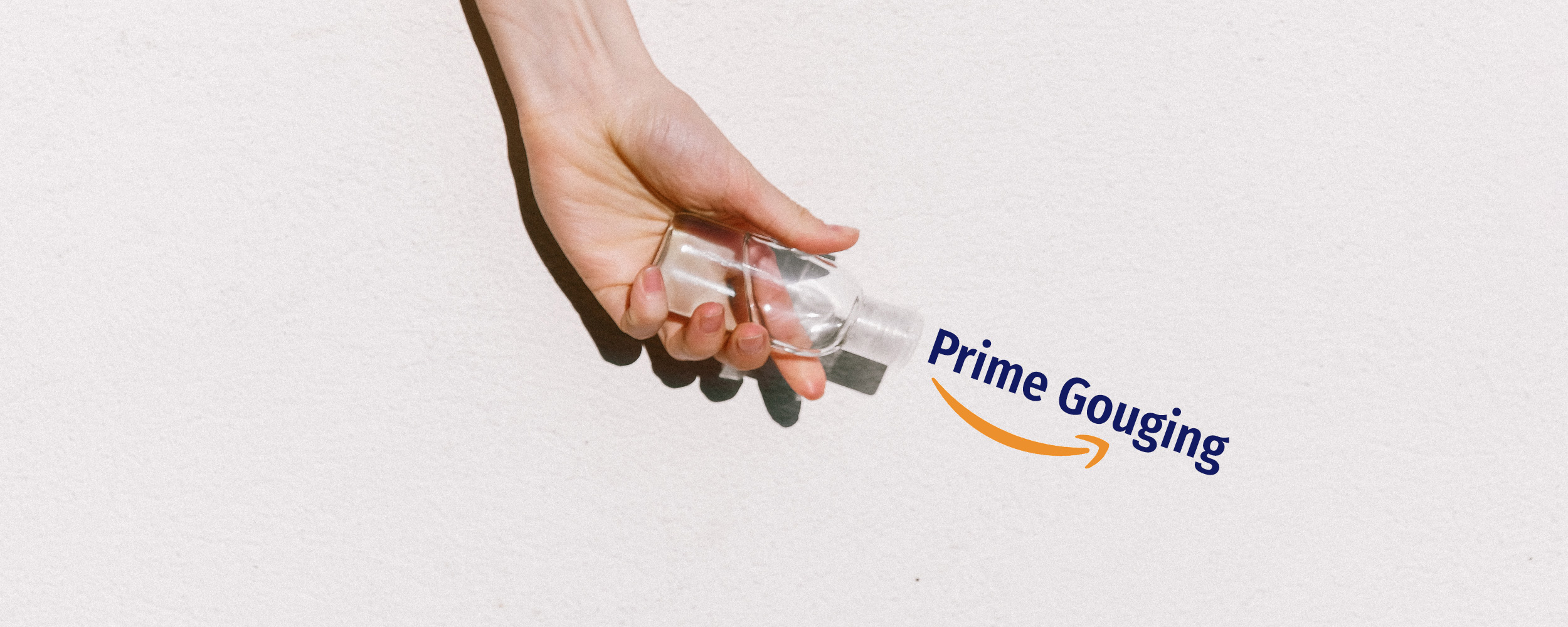
Prime Gouging
How Amazon Raised Prices to Profit from the Pandemic
Key Findings
- Amazon set prices of products during the COVID-19 pandemic to levels that would be considered violations of price gouging laws in many states.
- Amazon has misled the public, law enforcement, and policymakers about price increases during the pandemic.
- Numerous examples of price increases were found on essential products on Amazon.com, some as much as 1,000% over the expected price.
- Amazon publicly blamed so-called third-party sellers for price increases while continuing to allow third-party sellers to increase their prices.
- The facts in this report demonstrate the need for a federal price gouging law, and for Amazon to reform pricing and product listing practices.
I. Introduction
As the coronavirus COVID-19 pandemic took hold in the United States in late February / early March 2020, reports of product shortages, hoarding, and massive price increases soon arose. And once the pandemic response moved from emergency declarations to stay-at-home orders, the public increasingly turned to online shopping and delivery. Amazon, which is by far the biggest online seller in the world, experienced a dramatic increase in revenue.[1] But prices also spiked on Amazon, leading to accusations of price gouging on its online marketplace. Amazon responded by blaming the skyrocketing prices on unscrupulous third-parties that sell on its website. By taking a public stance against price gouging, Amazon portrayed itself as an unwitting victim.
Amazon claimed that it took several steps to curb price gouging. These steps included cooperating with law enforcement to identify third-party sellers engaged in price gouging, shutting down accounts of those suspected of price gouging, and ultimately calling for price gouging legislation
But we have uncovered a pattern of significant price increases on essential products sold directly by Amazon, as well as price gouging by third-party sellers.
This report details 15 essential products that have been sold by Amazon during that COVID-19 pandemic with markups over the recent price on Amazon.com or other national retailers ranging from 76% to more than 1,000%, and 10 products sold on Amazon by third-party sellers during the same period with markups ranging from 225% to 941%. Notably, some state price gouging laws prohibit price increases of as little as 10%.[2]
To address this problem, we make several recommendations including passage of a federal price gouging law as well as price transparency practices that Amazon should implement.
Amazon is trying to have the best of both worlds by enabling third-party sellers to exploit the crisis (and benefiting from facilitating those sales), but also seeking to immunize itself from responsibility for directly engaging in price gouging by shifting the focus on to the unscrupulous actions of third-party sellers, not only in the eye of the public but also in the eye of the law.
A Note on Methodology
The purpose of this report is to examine the ongoing price gouging on Amazon.com, both by third-party sellers as well as by Amazon itself. This involved tracking specific products through direct observation on Amazon.com, as well as through tracking websites Keepa.com and Camelcamelcamel.com.[3] Where possible, an effort was made to identify a contemporaneous price online at another national retailer of a similar or identical item. Despite reports of all manner of products experiencing significant price increases, including inflatable swimming pools and hand golf carts, products tracked in this report were limited to essential items to stick closely to items that would be covered under existing and proposed price gouging statutes.[4]
While there certainly have been reports of price gouging on other retail platforms during the COVID-19 pandemic, most public reports have been about price gouging on Amazon.[5] Further, from the beginning of the public health emergency, Amazon itself has been outspoken on the issue of identifying, stopping, and issuing policy proposals to address price gouging on the platform.[6] The focus on Amazon is also a product of the dominant force in retail that the company has become. Amazon reportedly accounts for 40% of all online sales, with its closest competitor making up around just 5%.[7] Amazon carries all manner of consumer products, with one estimate of 1.5 billion items listed.[8]
As the report will show, there are numerous products offered by third-part sellers that have been listed with significant price increases weeks and months after Amazon made public proclamations that it had taken action to stop the practice. What is more troubling is that the highest percentage price increases that this report has identified were on products listed as “sold by Amazon.”
II. Background on Price Gouging During the COVID-19 Pandemic
As the COVID-19 pandemic took hold through the early months of 2020, first in China and then across the world, demand increased for respirators and surgical masks.[9] By the time the first U.S. death from COVID-19 had been reported on February 29, 2020,[10] reports of price gouging on sales of protective masks on Amazon had already resulted in a warning from Amazon to third-party sellers against engaging in price gouging.[11] Soon, brick and mortar retail stores such as Target, Costco, and Kroger began to impose limits on the quantity of certain products each customer could purchase because of shortages and hoarding of products such as toilet paper, hand sanitizer, and disinfectants.[12] Increased demand for essential products on online marketplaces didn’t manifest in empty shelves – it meant sellers charging excessive prices[13]. As the pandemic worsened, so too did the price gouging on Amazon.
States Declare Emergencies and Issue Stay-At-Home Orders
On February 29, 2020, Washington Gov. Jay Inslee (D) declared a state of emergency in response to the first reported deaths from the coronavirus.[14] The next day the governor of Florida issued an executive order declaring a state of emergency.[15] In the following days other states began to follow suit, and by March 18, 2020, every U.S. state and territory had declared an emergency.[16] Nearly all of these orders have been renewed or continue to be in effect.[17]
In some states, such as New Jersey and Illinois, the governors’ emergency declarations expressly prohibited price gouging, typically defined as unreasonable or excessive price increases on certain essential products during an emergency.[18] While in other states, the disaster declaration triggered an existing statute prohibiting price gouging.[19]
Over the next period of weeks, one by one, states began to issue so-called “stay-at-home” orders whereby residents were directed to stay at home, shelter in place, and practice social distancing.[20] Essential travel, including shopping at grocery and drug stores was exempted from the orders, but with shortages and the fear of spreading the virus, millions of Americans turned to food and retail delivery services, including, and especially Amazon.[21]
Amazon has benefited from a significant increase in sales during the pandemic.[22] The policies put in place to prevent the spread of the coronavirus directly contributed to massive growth in on-line sales of almost 60%, and no company was able to benefit as much as Amazon.[23] Amazon’s second quarter earnings report, which covered the period beginning when most stay-at-home orders were first put in place, included a 40% increase in sales and a 100% increase in profits.[24] To manage the growth in sales volume, Amazon has reportedly hired 175,000 new employees since March 2020.[25]
The consumer reliance on Amazon due to pandemic made the widespread reports of price gouging that much more concerning.
Amazon Points Fingers in Response to Reports of Price Gouging
In the early days of the COVID-19 pandemic, the first reports of price gouging on Amazon began to surface.[26] In response, the company blamed the high prices on third-party sellers calling them “bad actors.”[27] Amazon declared that “there is no place for price gouging on Amazon.”[28] The company pointed to its so-called “Fair Pricing Policy,” which prohibits “setting a price on a product or service that is significantly higher than recent prices offered on or off Amazon,” and promised that those who violate the policy will be removed from the retail platform.[29] Amazon’s vice president of public policy then touted to the public that the company had turned over information about third-party sellers engaged in price gouging to 42 state attorneys general, as well as federal prosecutors.[30] Amazon CEO Jeff Bezos used the same talking points in his shareholder letter, in which he declared “Amazon is acting aggressively to protect our customers from bad actors looking to exploit the crisis.”[31]
With all the public proclamations and protestations by Amazon that they were cracking down on price gouging from the very beginning of the public health crisis, one would expect that the price gouging problem would have been addressed and stopped. Amazon, in its own publications, claimed to have removed half a million listings and suspended 6,000 sellers.[32] Some have even claimed that this widespread crackdown led to shortages on the platform when other sellers removed listed items for fear of violating a pricing policy that was unclear.[33]
Unfortunately, it is not like this has not happened before. About two years earlier, during Hurricane Irma, Amazon was alerted to price gouging on bottled water and other essential goods, took no action to address the problem, and encouraged customers to contact customer service if they have a complaint.[34] Instead of implementing a solution to this problem it has known about for years, Amazon coordinated a public relations campaign attempting to wash its hands of price gouging, laying the blame on third-party sellers all while it got undeserved credit for protecting consumers. It is implausible to think third-party sellers on the most sophisticated online marketplace in history actually raised prices in violation of a written policy without Amazon noticing. And as this report demonstrates, price gouging has continued on Amazon.
State Price Gouging Prohibitions Take Effect
Price gouging is illegal in about 35 states. Because there is no federal law protecting consumers from price gouging, states provide the only defense from unscrupulous sellers. While statutes and prohibitions vary across the states, they consistently include three facets. First, price increases are only prohibited when there is a declared emergency (hurricanes, earthquakes, flooding, or pandemics). Second, price increases are only prohibited on specific set of products that are deemed necessary or essential. Third, the price increase must be due to the presumed increase in demand because of the emergency and not due to some other factor such a regular seasonal price increase or a new supplier. Some states only hold the retail seller responsible, while other states will hold sellers further up in the supply chain responsible for the illegal price increases. It is not a violation of price gouging laws for a merchant to simply pass along an increase in wholesale supply or delivery costs to consumers.[35]
The amount of increase in prices that violate price gouging statutes vary from state to state. Some state price gouging laws designate a specific percentage increase over which a price increase would be considered gouging. The prohibited percentages range from 10% to 25%. Other state laws use less precise language to describe prohibited price increases such as: “excessive,” “grossly exceeds,” “unreasonable,” “exorbitant,” or “unconscionable.”[36]
Products covered by price gouging statues range from state to state. For example, in the District of Columbia the prohibition covers “any merchandise or service,” [37] but in Virginia the prohibition covers:
“Necessary goods and services for which consumer demand does, or is likely to, increase as a consequence of the disaster, and includes, but is not limited to, water, ice, consumer food items or supplies, property or services for emergency cleanup, emergency supplies, communication supplies and services, medical supplies and services, home heating fuel, building materials and services, tree removal supplies and services, freight, storage services, housing, lodging, transportation, and motor fuels.”[38]
By March 18, 2020, all states and territories had declared an emergency related to COVID-19, meaning that anti-price gouging rules went into effect in every state where a price gouging statute existed.
Amazon Calls for Federal Price Gouging Legislation
After two months of media reports of price gouging on its platform, Amazon publicly called for a federal price gouging law “to ensure there are no gaps in protection for consumers” and to “complement” the efforts to fight price gouging in the states.[39] The framework preferred by Amazon would include elements from many state statutes, including prohibitions on “unconscionable” price increases and an allowance for actual cost increases. The Amazon framework recommended that price gouging prohibitions go into effect whenever a federal public health or national emergency is declared. Notably, Amazon would have the prohibition apply to all levels of the supply chain rather than just retailers. However, the Amazon proposal would include language to clarify that the price gouging prohibition “should apply to the party who actually sets the price.” If it became law, this language would immunize Amazon from liability for price gouging by third parties that sell on its platform.
In calling for a federal price gouging statute, Amazon argues that a federal law would protect consumers where there are existing gaps in the law, “complement the great work being done by state attorneys general,” and provide clear guidance to potential price gougers as well as “honest sellers.”[40]
The nature of online platforms which transcend state borders has made price gouging enforcement increasingly more difficult at the state level. In March, Kentucky Attorney General Daniel Cameron worked with Amazon to identify third-party sellers based in Kentucky who were engaging in price gouging of essential emergency and medical supplies, issued cease and desist orders to more than half the sellers. He issued subpoenas to six of them.[41] In response, the Online Merchants Guild filed a lawsuit against Cameron taking the position that the Kentucky price-control statutes are unconstitutional when applied to Kentucky merchants who sell on a national marketplace like Amazon.[42]
A federal court in Kentucky agreed with the Online Merchants Guild, and granted a preliminary injunction against the Kentucky price gouging law finding that targeting Amazon sellers who sell on a national platform violates the U.S. Constitution under a principal called the “dormant Commerce Clause.”[43] Put simply, the court held that the Kentucky price gouging law is likely unconstitutional because it attempts to regulate prices outside of Kentucky. This decision ultimately could prevent any state price gouging law from applying to online sales platforms such as Amazon.
With this latest legal development, combined with the minority of states that have no price gouging protections, it is clear that a federal price gouging prohibition that augments existing state protections is urgently needed.
III. Amazon Is Engaged in Price Gouging on Products It Sells Directly
While the initial media and law enforcement focus of price gouging was on third-party sellers, this report establishes that Amazon is directly selling items at significantly above the regular market price despite publicly stating that the company is fighting price gouging.
This report will focus on essential products, that would be covered under an existing or proposed price gouging statute, that saw the most notable price increases during the COVID-19 pandemic.
Note: All products in this section were listed as “sold by Amazon,” and not sold by third-party vendors.
Figure 1: Examples of Price Gouging on Products Sold by Amazon
| Product | Amazon Price | Expected Price | Date Range | % Increase |
| Disposable Face Masks, package of 50 | $39.99 | ~$4.00 | April 1 – Aug. 16 | 1000% |
| Hand Sanitizer | $35.38 | ~$24.00 | May 10 – Aug. 16 | 48% |
| Disinfectant Spray | $13.04 | $6.99 | Aug. 1, 2019 – Aug. 16, 2020 | 87% |
| Antibacterial Soap | $7.00 | $1.49 | May 19 – Aug. 16, 2020 | 470% |
| Nitrile Disposable Gloves | $29.95 | $8.91 | Aug. 1, 2019 – Aug. 2020 | 336% |
| Toilet Paper | $36.39 | $6.89 | May 26 – Aug. 16, 2020 | 528% |
| Paper Towels | $46.94 | $15.49 | May 1 – Aug. 16, 2020 | 303% |
| Flour | $80.35 | $18.88 | May 1 – Aug. 16, 2020 | 425% |
| Sugar | $5.56 | $1.07 | May 1 – Aug. 16, 2020 | 520% |
| Corn Starch | $8.99 | $0.89 | Feb. 1 – Aug. 16, 2020 | 1010% |
Source: Author observations of prices at Amazon.com, Keepa.com Camelcamelcamel.com and other retail sites as necessary.
Disposable Face Masks Package: 1000% Price Increase
It is difficult to make apples-to-apples comparisons of the prices of disposable face masks because those sold during the pandemic tend to be from new sources. Nonetheless, roughly equivalent products are priced far higher than they were before the onset of the pandemic. In addition, the sourcing for the products appears to have shifted to unknown imported brands of questionable quality and reliability. The example below was first made available on Amazon in April and has been priced as high as $39.99. Prices for this type of package of 50 masks generally were around $4 before the pandemic.[44] The graph below shows the Amazon price over time and indicates that it was sold by Amazon, not a third-party seller.[45] Many of the reviews for this product indicate that the straps fall off and that the packaging is open or does not contain the specified amount of masks.[46]
Other retailers have largely sold out of this type of product, but where we were able to find comparable products, the price was similar. This is a disturbing example of a price rising due to demand and holding despite a prohibition on exactly this type of price gouging.
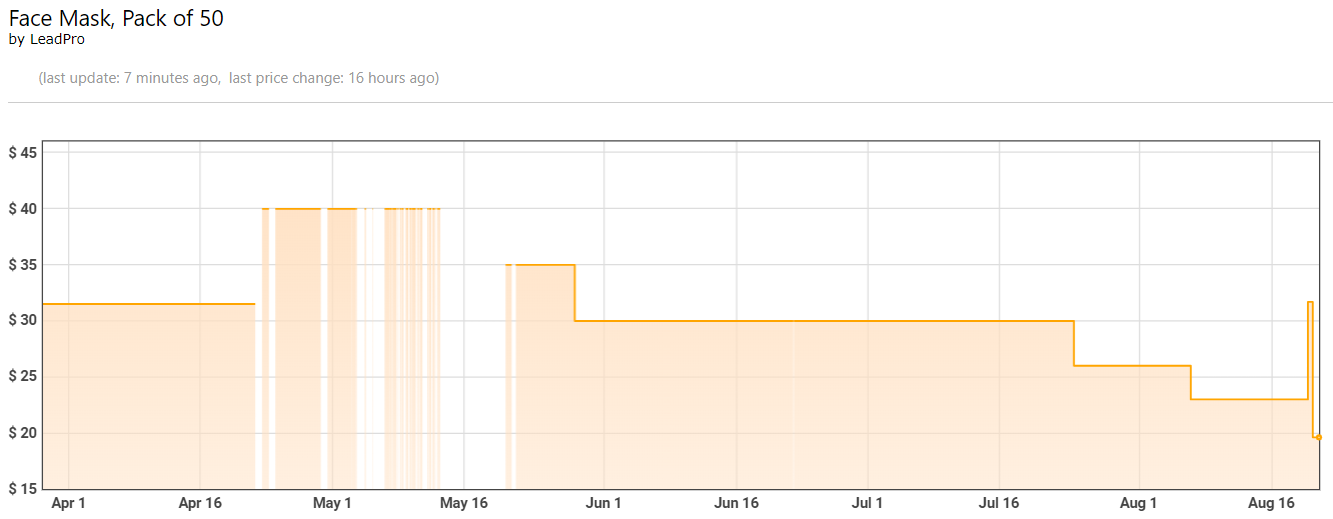
Hand Sanitizer: 48% Price Increase
Major brand name hand sanitizer is largely unavailable on Amazon.com. The U.S. Food and Drug Administration has issued a strong warning against more than 100 hand sanitizer products because of methanol contamination.[47] Consumers attempting to purchase hand sanitizer now face the difficulty of finding a product that is not only safe and available but also affordable.[48] On August 16, 2020, Amazon sold a 12-pack of 8oz. “Germ-X Hand Sanitizer” for $35.38.[49] The same day, a similar 8oz. Germ-X hand sanitizer bottle was sold for $1.99 on another retail site.[50] Notwithstanding typical quantity package discounts, this reflects a significant increase over the expected price.
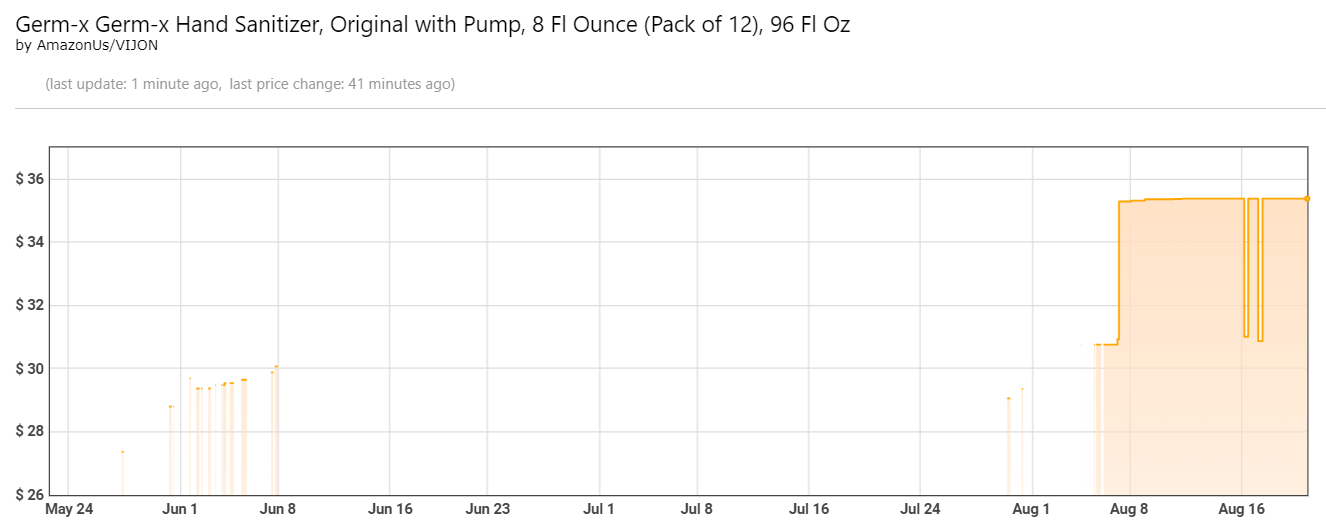
Disinfectant Spray: 87% Price Increase
Antibacterial disinfectant sprays continue to be hard to find on online retailers including Amazon.com. This “Bissell Woolite Advanced Stain and Odor Remover + Sanitize” is categorized under carpet cleaning but claims to kill 99.9% of bacteria. It has been available on Amazon for over five years priced at $6.99 but has been marked up routinely since March 19, 2020, when it was priced at $13.04.[51]
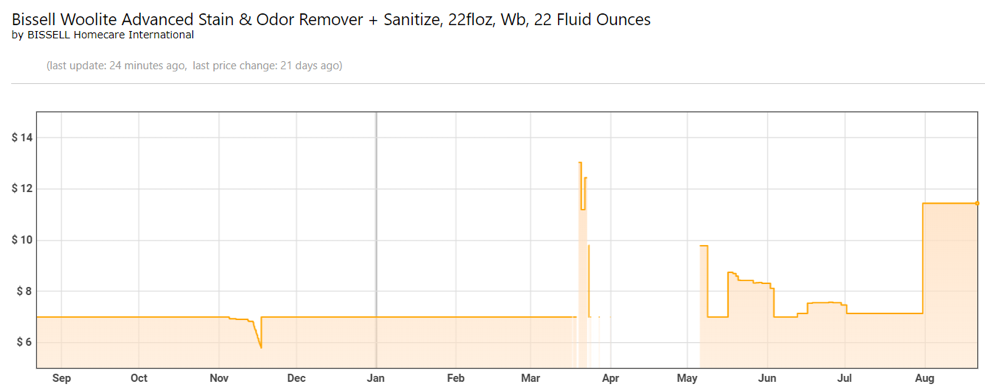
Antibacterial Soap: 470% Price Increase
Antibacterial hand soap has become more available since the shortages at the beginning of the pandemic, but Amazon.com still has limited options available. One example is “Dial Liquid Hand Soap, Spring Water, 7.5 Fl. Oz” which has been priced on Amazon.com in recent months as high as $7 and as low as $1.49.[52]
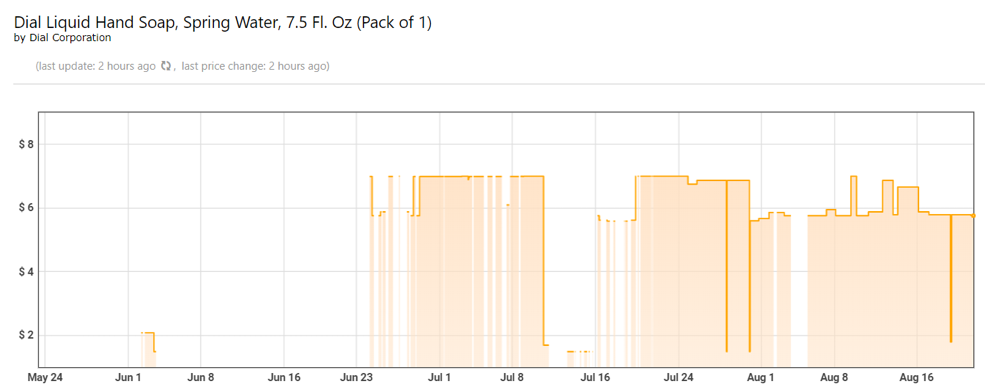
Nitrile Disposable Gloves: 336% Price Increase
The pack of 100 “Safeguard Nitrile Disposable Gloves” is sold on Amazon.com for $29.95 but has previously been sold by Amazon for as little as $8.91.[53]
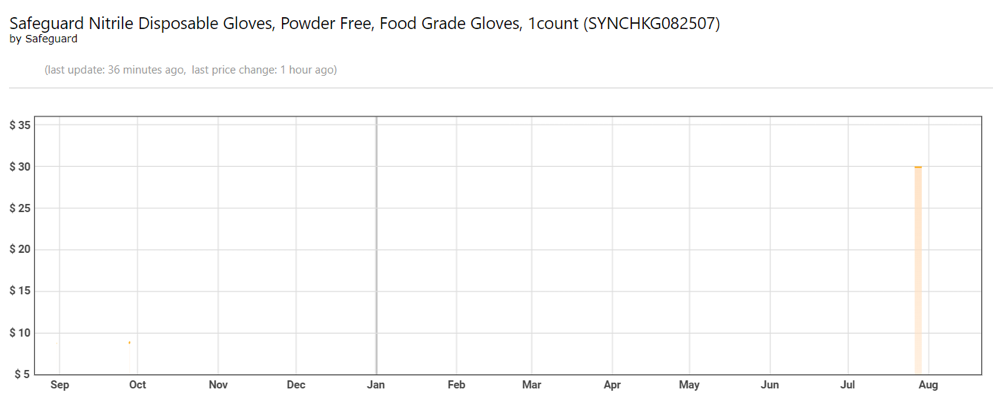
Toilet Paper: 528% Price Increase
Toilet paper is arguably the most notorious product impacted by the COVID-19 pandemic.[54] From empty store shelves, to customers fighting over the last package, the story of hoarding toilet paper was a frequent subject for journalists.[55] One contributing factor to the shortages was shift from work to home as business grade toilet paper is a different product with a different supply chain than that sold for home use.[56]
Amazon has recently sold “Scott 1000 Sheets Per Roll, 8 Toilet Paper Rolls” for as much as $36.39.[57] This represents a 528% price increase over the $6.89 that other retailers are have charged for the same product, and a 260% increase over the lowest price at which Amazon has sold this item.[58]
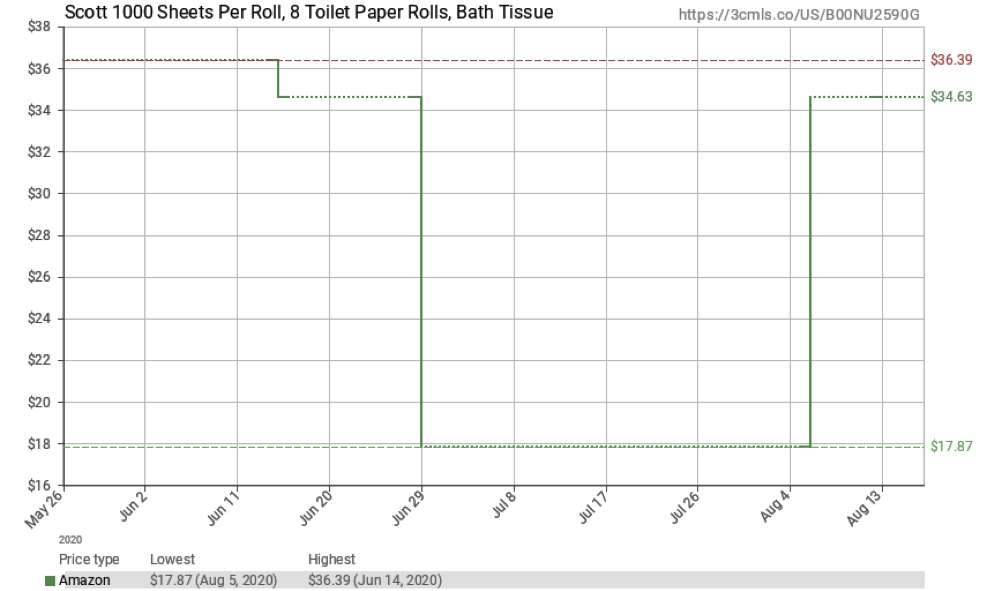
Amazon recently has sold “Quilted Northern Ultra Soft and Strong Toilet Paper, Mega Rolls, 12 Count of 328 2-Ply Sheets Per Roll” for $32.25, a 283% increase over the recent low of $11.38.[59]

Amazon recently has sold “Quilted Northern [Ultra Plush] Bathroom Tissue, 18 Count” for $37.93, a 217% increase over the recent lowest price of $17.48.[60]
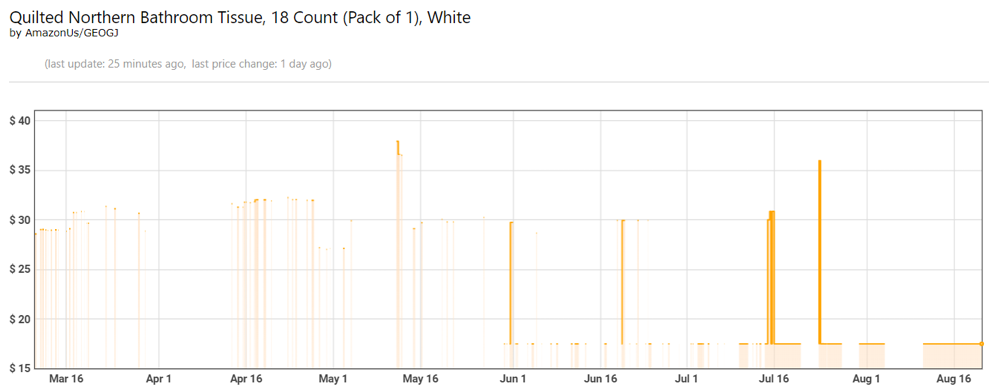
Amazon recently has sold “Quilted Northern Ultra Plush Toilet Paper, 24 Mega Rolls” for $41.96, a 76% increase over the lowest price of $23.78 that Amazon has charged.[61]
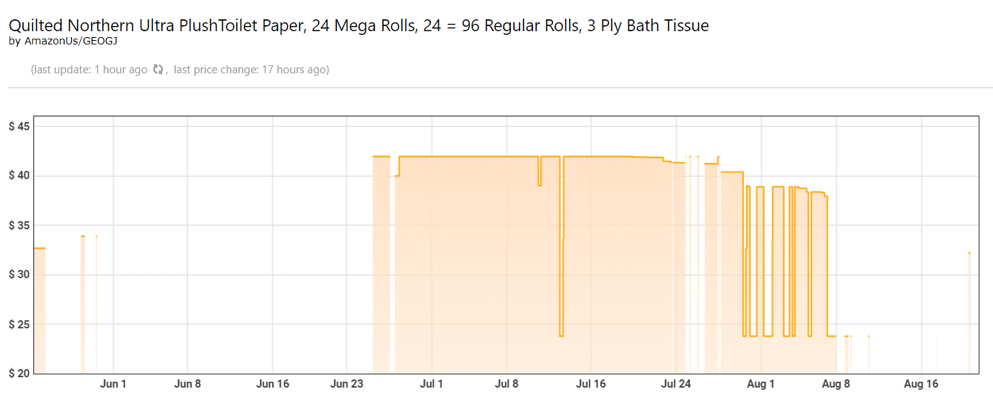
Paper Towels: 303% Price Increase
Like with toilet paper, at the onset of the COVID-19 pandemic retail stores quickly sold out of paper towels.[62] Amazon recently sold “Brawny Tear-A-Square Paper Towels, 8 Rolls” for $46.94, a 303% increase over the recent low price of $15.49.[63]
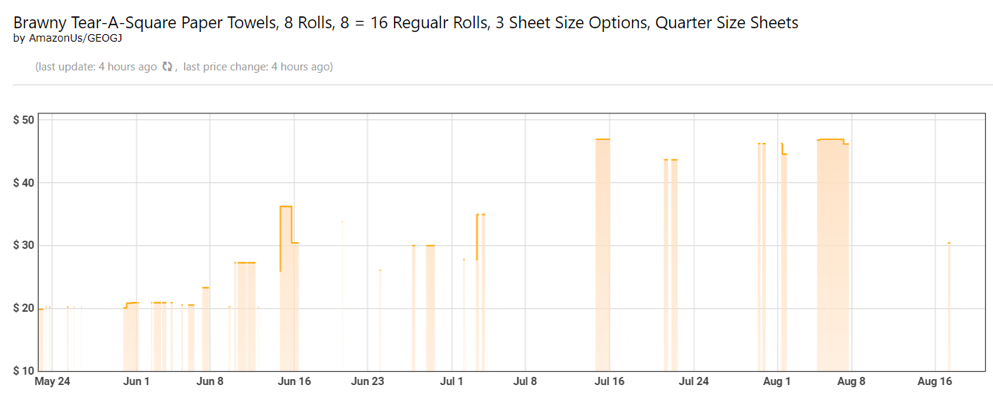
Amazon recently sold “Sparkle 2-Ply Perforated Roll Paper Towels,” 15 roll case for $42.45, a 201% increase over the January 2020 price of $20.99.[64]
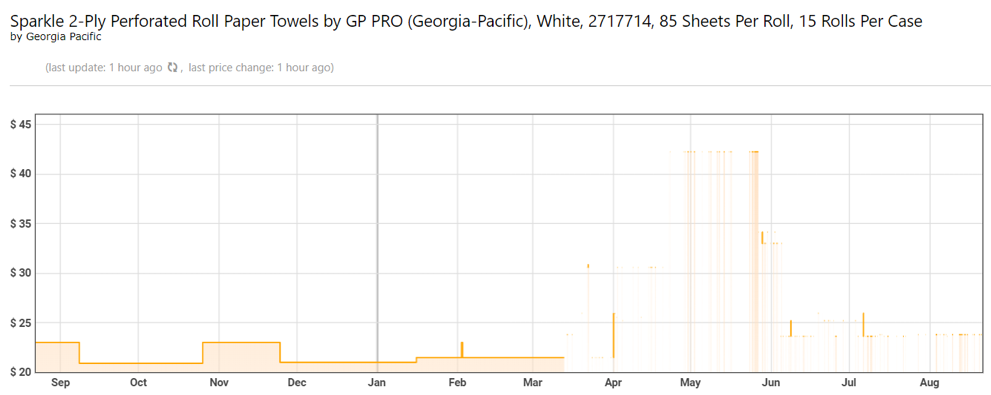
Flour: 425% Price Increase
One of the unique features of the COVID-19 pandemic is how it changed behavior over a sustained period of time. Because so many people spent so much time at home with their families, habits and patterns changed. A surprising example was the increase in home baking, and the shortages of key ingredients like flour, yeast, corn starch, and sugar. Unlike some of the hoarding and panic buying that led to shortages of other more obvious products, the shortages in baking ingredients have been due to an actual increase in consumption and have been sustained.[65]
Amazon recently sold “Pillsbury BEST All Purpose Unbleached Flour, 5 Pound (Pack of 8)” for $80.35.[66] This is just over $10 per bag of flour that typically sells for as little as $2.36 at other online retailers.[67] This is a 425% increase.
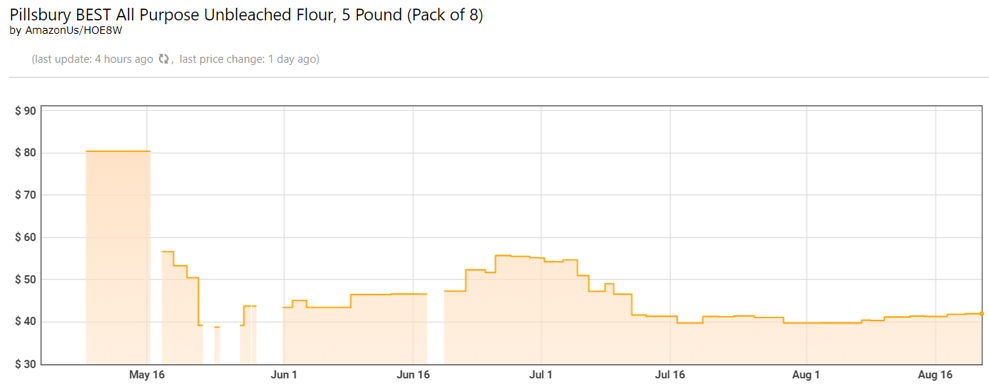
Amazon recently sold “King Arthur Flour All-Purpose Flour, 10 Pound” for $19.87, a 317% increase over of the $6.27 other retailers have charged for this item.[68]
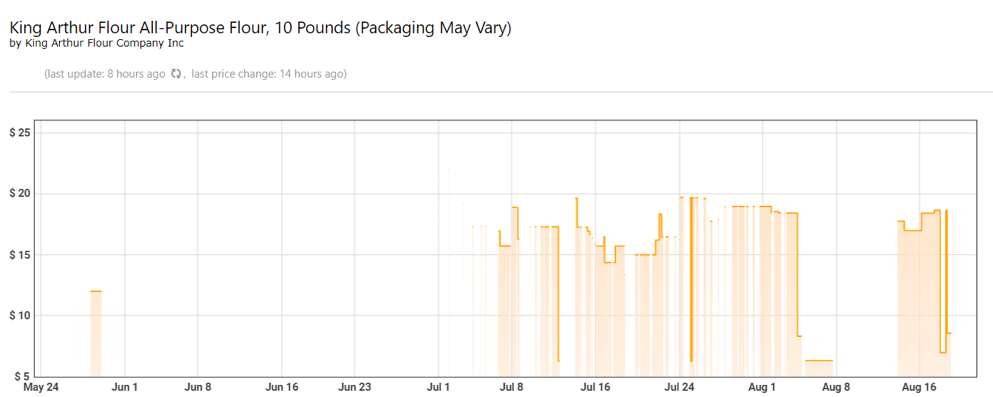
Sugar: 520% Price Increase
Like with flour, shortages and increased demand have been common with sugar. Amazon recently sold “Domino Pure Cane Confectioners Powdered Sugar, 1 lb” for $5.56 per box, representing a 520% increase over the $1.07 other retailers have priced the same item.[69]
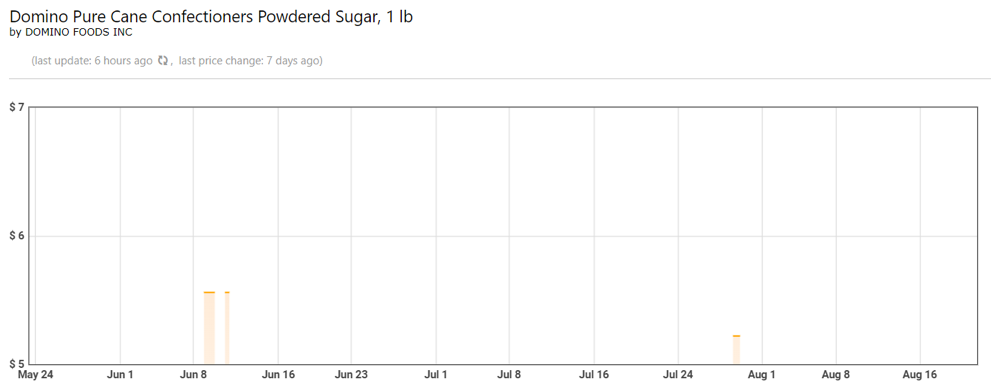
Corn Starch: 1010% Price Increase
Another baking ingredient that Amazon has been selling at a significant increase is corn starch. Recently, Amazon sold “Clabber Girl Corn Starch, 6.5 Ounce” for $8.99, a stunning 1010% increase over the $0.89 that other retailers charge for this item.[70]
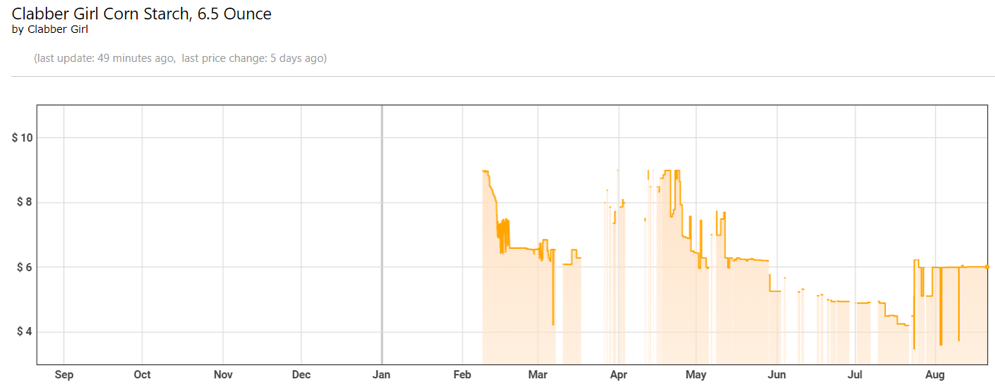
IV. Amazon’s Third-Party Sellers Are Engaged in Price Gouging
In addition to Amazon’s direct price gouging, third-party sellers continue to engage in price gouging behavior on the site. Because of its financial relationship with third-party sellers, Amazon also benefited from these increased prices across its platform.
Third-Party Sellers Account for 25% of Amazon Online Retail Revenue[71]
In 2019, Amazon reported that the company’s annual share of revenue generated by third-party sellers was $42.75 billion.[72] The latest Amazon earnings report from the second quarter of 2020 showed an increase of 53% to $18.2 billion for just that quarter.[73] This was not gross revenue. This is just the cut that Amazon kept in fees that average around 15%.[74] Some recent estimates have put that percentage much higher as a result of the advertising fees Amazon charges sellers outside of the list and fulfilment fees.[75] This is compared to the annual gross revenue for the Amazon retail operation of $122.99 billion, which is before cost of goods sold and other expenses. Thus, while third-party sales account for about 25% of the revenue from online retail, the costs associated with third-party sales are not comparable with Amazon retail costs. Put simply, third-party sellers are a very important, and growing, part of Amazon’s revenue.
This financial relationship is important to understand, as it demonstrates that Amazon heavily relies on third-party sellers and directly benefits when third-party seller revenue increases.
Examples of Price Gouging on Products Sold by Third-Party Sellers
The essential items sold by third-party sellers identified in this section differ from those sold directly by Amazon detailed in the previous section due to the variance in availability, and the instances of actual price gouging in product categories.
Figure 2: Examples of Price Gouging on Products Sold by Third-Party Sellers
| Product | Amazon Third-Party Price | Expected/Lowest Price | Date Range | % Increase | |
| Hand Sanitizer | $109.98 | $27.01 | April 26 – Aug. 16, 2020 | 407% | |
| Disinfectant Spray | $24.89 | $5.99 | Aug. 1, 2019 – Aug. 16, 2020 | 416% | |
| Antibacterial Soap | $50.00 | $7.74 – $18.24 | Aug. 1, 2019 – Aug. 16, 2020 | 274% | |
| Toilet Paper | $100.00 | $26.24 | June 1 – Aug. 16, 2020 | 381% | |
| Paper Towels | $53.99 | $12.00 | Aug. 1, 2019 – Aug. 16, 2020 | 450% | |
| Flour | $59.00 | $6.27 | Aug. 1, 2019 – Aug. 16, 2020 | 941% | |
| Rice | $19.99 | $3.12 | Aug. 1, 2019 – Aug. 16, 2020 | 641% | |
| Pasta Sauce | $24.95 | $7.99 | Aug. 16, 2019 – Aug. 16, 2020 | 312% | |
Sources: Author observations of prices at Amazon.com, Keepa.com Camelcamelcamel.com and other retail sites as necessary.
Hand Sanitizer: 407% Price Increase
Amazon has recently listed “Germ-x Hand Sanitizer, Flavor may vary ( Original / fresh citrus ), 8 Fl Oz, Pack of 12” sold by third-parties for as much as $109.98.[76] This represents a 407% price increase over the $27.01 price at which other third-party sellers on Amazon have recently listed the item.
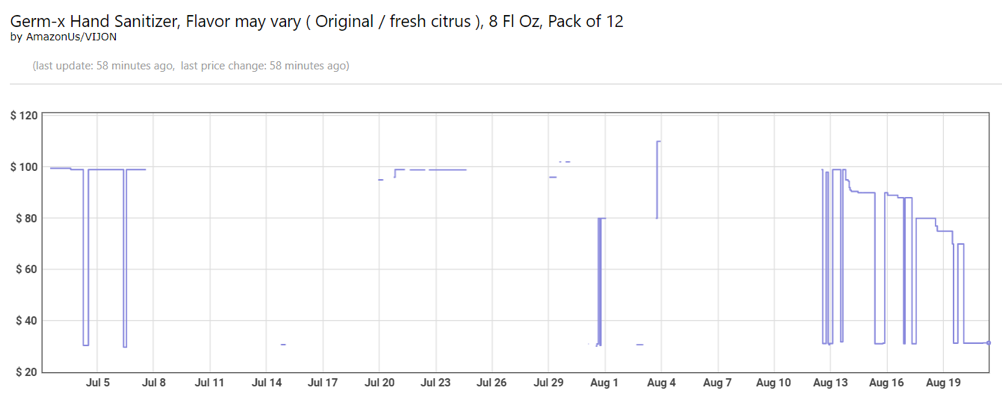
Disinfectant Spray: 416% Price Increase
Amazon has recently listed “Spic And Span Antibacterial Spray Cleaner, 22 oz (2 Bottle Multipack)” sold by third-party sellers for $24.89.[77] This reflects a 416% price increase over the lowest recent price listed by other third-party sellers on Amazon.com of $5.99.
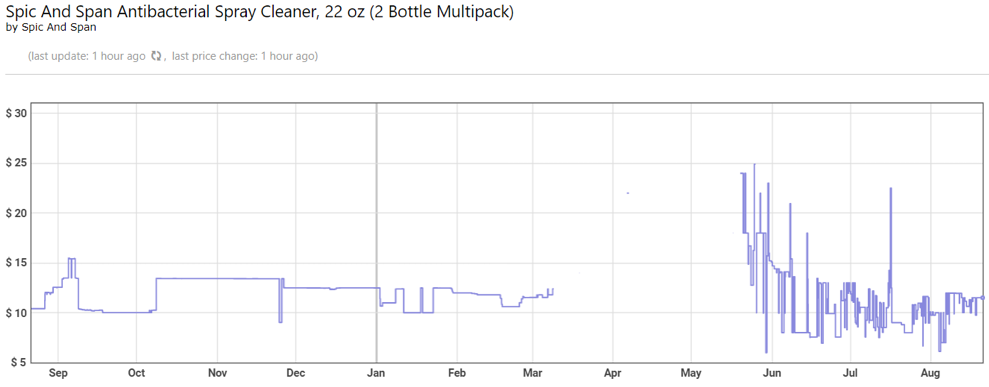
Antibacterial Soap: 274% Price Increase
Amazon recently listed “Dial Liquid Soap Anti-Bacterial White Tea 7.5 Ounce Pump (221ml) (Pack of 6)” sold by third-party sellers for $50.[78] This is a 274% price increase over the $18.24 price listed by third-party sellers before the COVID-19 emergency declarations. It is notable that this item typically sells for less than $1.29 per unit at other retail stores and even the previous lower price of $18.24 is a significant mark-up.
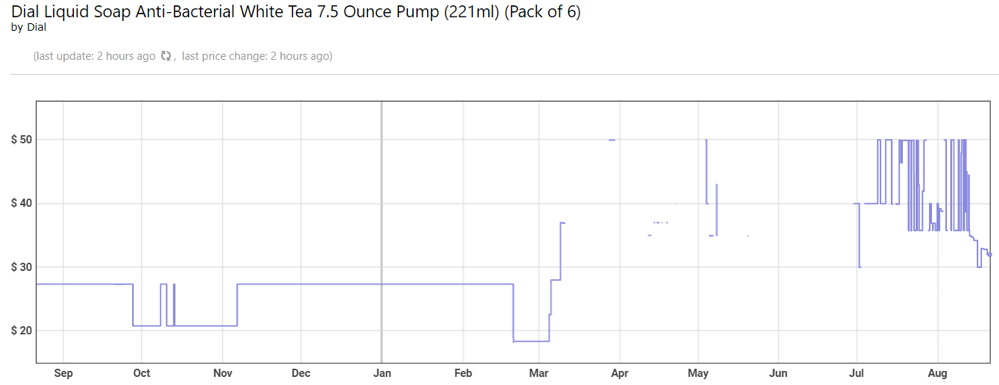
Toilet Paper: 381% Price Increase
Amazon recently listed “Charmin Ultra Soft Cushiony Touch Toilet Paper, 18 Family Mega Rolls = 90 Regular Rolls” sold by third-party sellers for $100.[79] This reflects a 381% price increase over the recent lowest third-party seller price of $26.24.
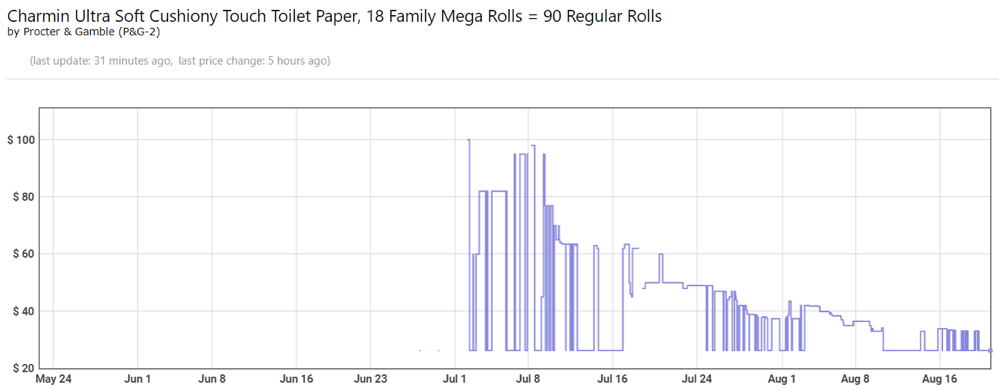
Amazon recently listed “Charmin Ultra Strong Clean Touch Toilet Paper, 18 Family Mega Rolls = 90 Regular Rolls” sold by third-party sellers for $59.[80] This reflects a 225% price increase over the recent lowest third-party price of $26.24.
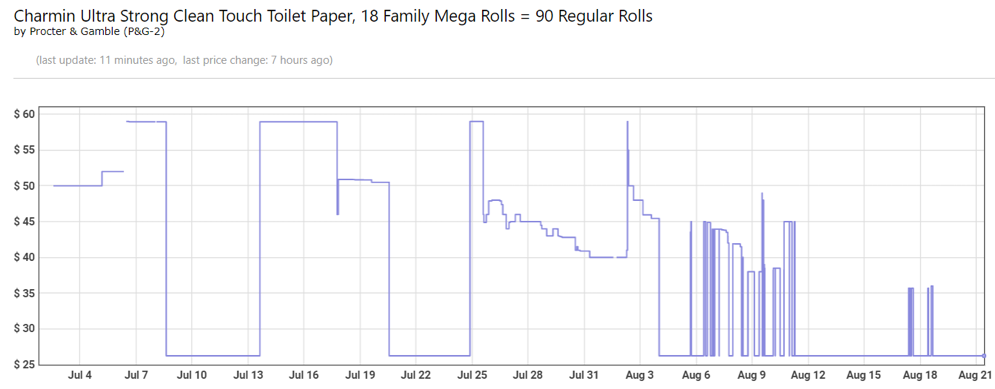
Amazon recently listed “Quilted Northern Bathroom Tissue, 18 Count (Pack of 1), White” sold by third-party sellers for $55.[81] This amounts to a 315% price increase over the recent lowest third-party seller price of $17.48.
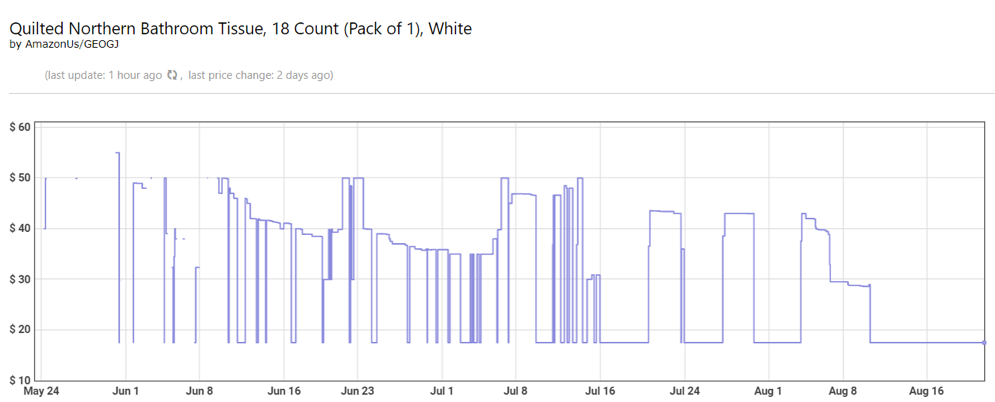
Paper Towels: 450% Price Increase
Amazon recently listed “Bounty 74795 Select-A-Size Paper Towels, 20 Fluid Ounce” sold by third-party sellers for $53.99.[82] This reflected a 450% price increase over the $12 price listed by third-party sellers in the days leading up to the COVID-19 emergency declarations.
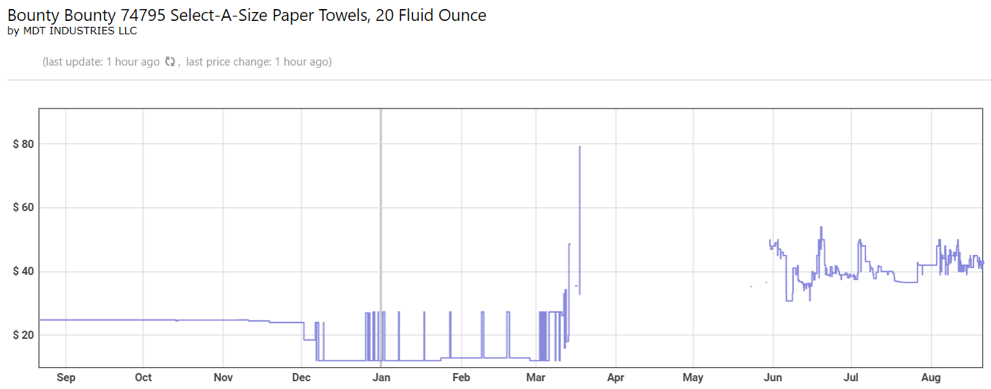
Flour: 941% Price Increase
Amazon recently listed “King Arthur Flour All-Purpose Flour, 10 Pound” sold by third-party sellers for $59.[83] This reflects a 941% price increase over the lowest recent third-party seller price of $6.27.
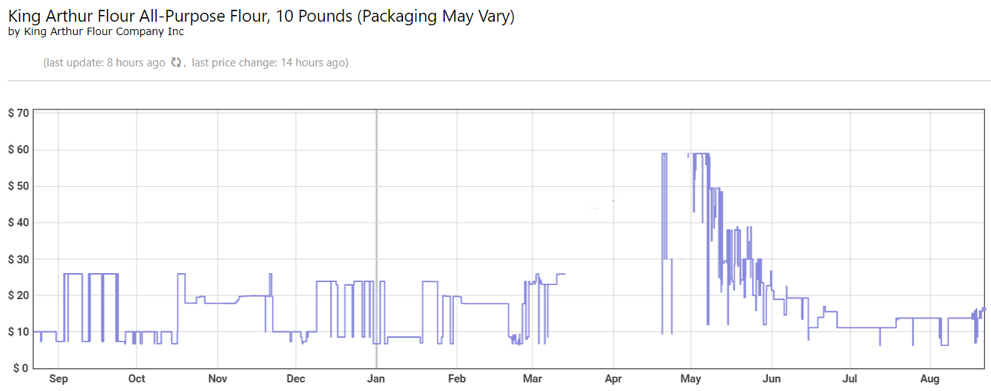
Rice: 641% Price Increase
Amazon recently listed “Goya Canilla Enriched Extra Long Grain Rice, 48oz, Arroz Enriquecido de Grano Extra Largo” sold by third-party sellers for $19.99.[84] This is a 641% price increase over the $3.12 price that other retailers charge for this item and a 155% increase over the $12.93 price that was listed on the online platform by third-party sellers before the COVID-19 pandemic stay-at-home orders took effect.
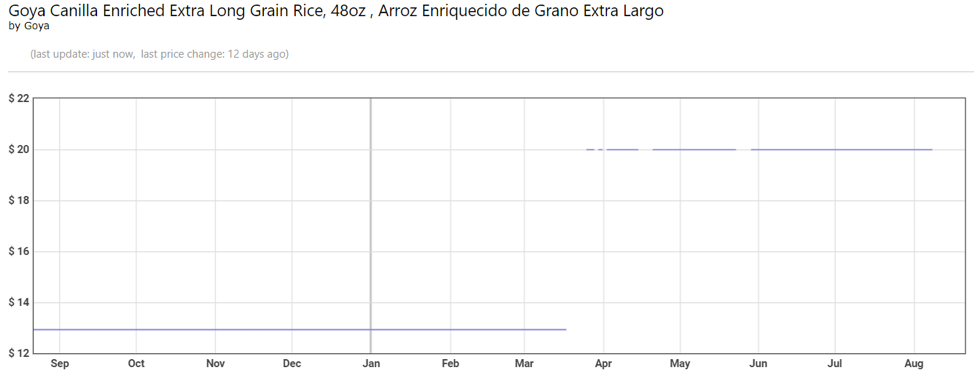
Pasta Sauce: 312% Price Increase
Amazon recently listed “Rao’s Homemade Arrabbiata Pasta Sauce 24oz” sold by third-party sellers for $24.95.[85] This is a 312% price increase over the $7.99 price other retailers charge for this product and a 240% increase over the lowest price of $10.39 recently listed by third-party sellers on Amazon.
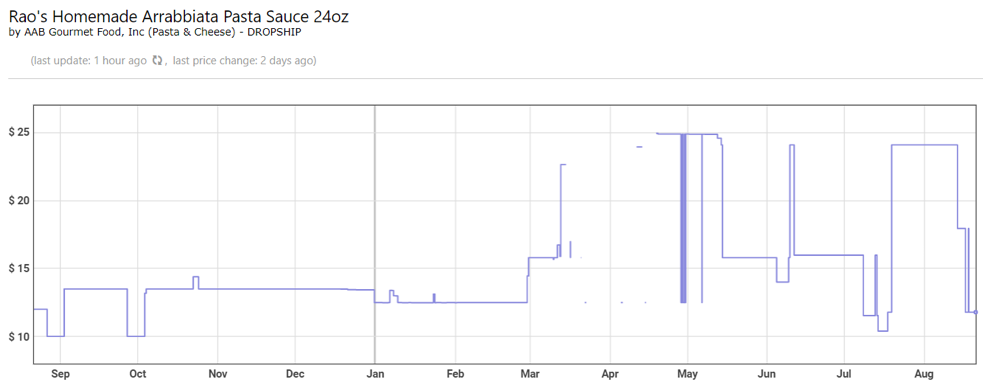
V. Recommendations
Enact a Federal Price Gouging Statute
There is currently no federal price gouging law. The absence of a federal law, combined with online shopping that transcends state borders, has created gaps in protection from price gouging, and has led to the potential for state price gouging laws to be ineffective at addressing online price gouging. We recommend a uniform, federal protection against price gouging that would serve as a floor, while allowing states to have greater protections. Specifically, a federal price gouging law should:
- Provide a clear and unambiguous definition of price gouging such as a 10% increase in prices during an emergency;
- Include a very broad list of products, goods, and services that would be covered;
- Establish significant civil penalties enforceable by the Federal Trade Commission and state attorneys general;
- Apply wherever price gouging occurs in the supply chain; and
- Be applicable during the current COVID-19 pandemic as well as any disaster or health emergency now and in the future.
Amazon Should Institute Price and Product Listing Reforms
It can be exceedingly difficult to determine if a product on Amazon is priced fairly. From multiple product pages, to prices shifting as often as every 10 minutes, to size and variety combinations that make comparison shopping challenging. We recommend that Amazon make these reforms to provide pricing transparency for consumers:
Publish suggested retail price, average price, and a link to price history next to every item listed on Amazon.com.
Consumers would benefit from the ability to see if the listed price is comparable to the manufacturer’s suggested retail price. An average price would show the consumer whether the current price is more or less than the typical price paid. The average price could be especially useful for products with significant price volatility. While several websites track Amazon prices, this data should be made available to Amazon customers directly as part of the shopping experience. If prices are moving upward, a consumer could see that trend by looking at price history and make an informed decision about whether or not they should make a purchase.
Limit upper end of the price range on all product listings.
A simple solution for so much of the problematic pricing would be to limit how much a price can increase from the time it is listed. This would keep price increases to a minimum and would stop price gouging on existing listings.
End the practice of creating new product pages for items previously listed.
When new product pages are created there is no previous price history attached to the page. This makes it difficult to evaluate prices. In some cases, it appears that new product pages have been created simply because of a new title or even a misspelling. Price history should be tied to a product not to an erroneous listing page.
List multi-pack items with individual item prices visible and require that multi-pack items reflect a quantity discount.
When items are packaged in large quantities it can be difficult to evaluate the price of the larger package. Where possible, a single unit price should be identified. This should be required for products listed available for individual sale in addition to, not in place of, a per ounce or other measurement of unit price.
Amazon policy should require that multiple quantity packages should always reflect a quantity discount. Quantity packaging communicates an expectation of discount to the consumer, and this should be true as a matter of policy. A quantity discount also should be clearly displayed on the listing page.
Separate data on price history and customer ratings by each item type on listings with multiple sizes or varieties.
When a product listing page contains multiple options including size, quantity, or variety, price tracking websites are unable to track the price of each option. The data for these types of listings should be broken out so that price histories can be maintained where different options result in different products and prices. In addition, customer reviews on these types of pages are unable to distinguish between the options selected. Thus, if a particular variety has more negative reviews than another, a consumer is unable to see the reviews and ratings on the specific product variety they have selected.
Create a single click option for consumers to report a product listing problem.
As with advertising and social media posts, consumers are used to reporting problematic content by clicking a “report” button. Amazon product listings that are erroneous, or that are suspected of price gouging or some other unfair pricing should be flagged for review by consumers. This would assist Amazon in identifying problem listings.
Conclusion
Price gouging is an exploitive business practice that manipulates markets and takes advantage of people at their most vulnerable and desperate. While some economic theories support price gouging as a function of supply and demand, they overlook the market manipulation that occurs when gougers contribute to scarcity by hoarding. Much of our society has decided that price gouging during an emergency is unacceptable and should be prohibited by law. Yet, despite general agreement that price gouging is wrong and a large majority of states with price gouging laws in place, the practice continues on Amazon.com.
Amazon’s leadership has made clear that they do not tolerate price gouging and that they will stop third-party sellers from taking advantage of the pandemic. However, it is clear that not only are third-party sellers engaged in price gouging, but Amazon itself is selling essential products at significant price increases, and in many cases at a much higher price than other national retailers.
It is troubling that so much effort was put into blaming third-party sellers, but so little effort was made to stop the price increases – including on the products sold by Amazon directly. Amazon is not merely a victim in the price gouging on its marketplace. It is a perpetrator.
A federal price gouging statute that augments state laws is needed to address this problem. It should be in place so that the next emergency, big or small, does not produce price gougers as this one has.
In addition, Amazon needs to make significant reforms to prevent abuse on its site, and to provide consumers with the tools necessary to identify problematic prices and report them. Amazon already has demonstrated a desire to be a leader in combating price gouging. By implementing these reforms Amazon could serve as a model for other online retailers to help prevent price gouging in the future.
During emergencies, people are scared, desperate, and in need. Price gouging is an insidious exploitation of the most vulnerable. There is no excuse for the most successful corporations preying on vulnerable consumers by price gouging.
[1] Cameron Faulkner, Amazon Doubled Its Profit During a Pandemic, The Verge (July 30, 2020), https://bit.ly/2FEBPps.
[2] Price Gouging Laws by State, FindLaw (March 24, 2020), https://bit.ly/3fKbq6T.
[3] See https://keepa.com/#!faq and https://camelcamelcamel.com/about.
[4] See Andrew Beaton, We’re Out of Toilet Paper, Hand Sanitizer—and Golf Pushcarts?, The Wall Street Journal (May 17, 2020), https://on.wsj.com/39utAa8; Winnie Sun, Why ‘Covidflation’ May Be Causing Havoc On Your Personal Budget And What You Can Do About It, Forbes (May 13, 2020), https://bit.ly/300PZsw.
[5] See Michelle Grant, Walmart, Costco and Trader Joe’s Accused of Inflating Egg Prices Amid Coronavirus Pandemic, Today (April 29, 2020), https://on.today.com/2ByKurH.
[6] Brian Huseman, How Amazon is Fighting Against Price Gouging Amid Coronavirus Pandemic, Tennessean (April 20, 2020), https://bit.ly/3jl4CP0.
[7] Pippa Stevens, This Breakdown of Retail Sales Data Shows Why Amazon is Leading The Stock Market, CNBC (May 15, 2020), https://cnb.cx/3fa3r1S.
[8] Neel Mehta, Parth Detroja, and Aditya Agashe, Amazon Changes Prices on Its Products About Every 10 Minutes — Here’s How And Why They Do It, Business Insider (Aug. 10, 2018), https://bit.ly/3f1oTWz.
[9] Naomi Xu Elegant, As Coronavirus Spreads, Facemasks Become A ‘Symbol Of Protection’—And A Lightning Rod For Fear, Fortune (Jan. 31, 2020), https://bit.ly/2ZGZk8M.
[10] Nicole Acevedo and Minyvonne Burke, Washington State Man Becomes First U.S. Death From Coronavirus, NBC News (Feb. 29, 2020), https://nbcnews.to/3jhozGy. Note, it was later reported that the first U.S. death from COVID-19 was actually February 6, 2020: Dennis Romero, 1st U.S. Coronavirus Death Was Weeks Earlier Than Initially Believed, NBC News (April 21, 2020), https://nbcnews.to/3eLb1jc.
[11] Louise Matsakis, As Covid-19 Spreads, Amazon Tries to Curb Mask Price Gouging, Wired (Feb. 25, 2020), https://bit.ly/32wct6B.
[12] Bailey Miller and Steve Nielsen, Panic Buying Continues Amidst Coronavirus Outbreak as Stores Impose Purchase Limits, FOX 10 Phoenix (March 9, 2020), https://bit.ly/30s77GL.
[13] Jessica Guynn, Mike Snider, and Kelly Tyko, Coronavirus Fears Spark ‘Panic Buying’ of Toilet Paper, Water, Hand Sanitizer. Here’s Why We All Need to Calm Down, USA Today (March 2, 2020), https://bit.ly/2OHK2uk.
[14] Office of the Governor, Proclamation by the Governor 20-05, State of Washington (Feb. 29, 2020), https://bit.ly/3jkN71s.
[15] Office of the Governor, Executive Order 20-51, State of Florida (March 1, 2020), https://bit.ly/39k6iUA.
[16] Status of State COVID-19 Emergency Orders, National Governors Association (July 16, 2020), https://bit.ly/2ZIbhLl.
[17] Id.
[18] Office of the Governor, Executive Order No. 103, State of New Jersey (March 9, 2020), https://bit.ly/2DSmqAO; Office of the Governor, Gubernatorial Disaster Proclamation on COVID-19, State of Illinois (March 9, 2020), https://bit.ly/3hiDEWx.
[19] Price Gouging Laws by State, FindLaw (March 24, 2020), https://bit.ly/3fKbq6T.
[20] Overview Of State Actions On Business Closure And Personal Movement Restrictions In Response To COVID-19, Appendix 1, National Governors Association (Updated April 13, 2020), https://bit.ly/2E9VblB.
[21] Jason Del Rey, Amazon Was Already Powerful. The Coronavirus Pandemic Cleared the Way to Dominance, Recode by Vox (April 10, 2020), https://bit.ly/2WJLWyY.
[22] Rupert Neate, $10,000 a second? Amazon’s results could be amazing, The Guardian (Apr. 18, 2020), https://bit.ly/3hFPSst.
[23] Eric J. Savitz, Amazon’s Gains From the Pandemic Shutdown Seem ‘Pretty Durable’, Barron’s (June 1, 2020), https://bit.ly/3eQMIQL.
[24] Jeremy C. Owens, Amazon promised to spend its profit amid pandemic, but ended up with record earnings anyway, MarketWatch.com (Aug. 1, 2020), https://on.mktw.net/3hXHOU4.
[25] David Goldman, Amazon delays Prime Day, but it’s still on for this year, CNN (Jul. 21, 2020), https://cnn.it/301NqX8.
[26] Jason Koebler, Matthew Gault, and Lauren Kaori Gurley, Amazon Is Out of Toilet Paper and It Won’t Answer Our Emails, Vice Motherboard (March 13, 2020), https://bit.ly/3hi5lim.
[27] Price Gouging Has No Place In Our Stores, The Amazon Blog: Day One (March 23, 2020), https://bit.ly/34xxoHi.
[28] Annie Palmer, Amazon Cracks Down on Coronavirus Price Gouging and Products Making False Claims, CNBC (Feb. 27, 2020), https://cnb.cx/3jl42ku.
[29] Amazon Marketplace Fair Pricing Policy, Amazon (viewed on July 20, 2020), https://amzn.to/3fNXj0m.
[30] Brian Huseman, How Amazon is Fighting Against Price Gouging Amid Coronavirus Pandemic, Tennessean (April 20, 2020), https://bit.ly/3jl4CP0.
[31] Jeff Bezos, 2019 Letter to Shareholders, Amazon (April 16, 2020), https://bit.ly/3jwpu67.
[32] Id.
[33] Spencer Soper, Amazon Price-Gouging Crackdown Worsened Shortage of Sanitizer, Wipes, Pittsburgh Post-Gazette (Jun. 12, 2020), https://bit.ly/32XNrNZ.
[34] Mike Snider, Hurricane Irma: A Case Of Water Sells For $99.99 On Amazon As Residents Fear Price Gouging, USA Today (Sept. 6, 2017), https://bit.ly/2BfpqGF.
[35] Price Gouging Laws by State, FindLaw (March 24, 2020), https://bit.ly/3fKbq6T.
[36] Id.
[37] D.C. Code § 28-4102 (1992), https://bit.ly/31VoDE9.
[38] VA. Code Ann. § 59.1-526 (2004), https://bit.ly/3h2KkZ3.
[39] Brian Huseman, It’s Time for Congress to Establish a Federal Price Gouging Law, Amazon (May 13, 2020), https://bit.ly/32NMhVc.
[40] Id.
[41] Kelly Dean, Kentucky Attorney General’s Office Continues to Warn of Price Gouging Amid Pandemic, WBKO (April 30, 2020), https://bit.ly/3037mZG.
[42] Ina Steiner, Merchants Sue Kentucky Over Price Gouging Actions, eCommerce Bytes (May 2, 2020), https://bit.ly/2WZfUz1.
[43] Kirsten Errick, Court Enjoins Ky. Price-Gouging Statute as Extraterritorial, Law Street (June 24, 2020), https://bit.ly/2CG4FVn.
[44] Louise Matsakis, As Covid-19 Spreads, Amazon Tries to Curb Mask Price Gouging, Wired (Feb. 25, 2020), https://bit.ly/32wct6B.
[45] Face Mask, Pack of 50, Keepa.com (viewed on Aug. 16, 2020), https://bit.ly/30WJy9l.
[46] See Customer Reviews, Face Mask, Pack of 50, Amazon.com (viewed on July 28, 2020), https://amzn.to/2D8NZpg.
[47] Kelly Tyko, FDA’s list of hand sanitizers to avoid grows again with more than 100 identified that may contain methanol, USA Today (Aug. 1, 2020), https://bit.ly/2Xmsk4c.
[48] FDA Updates on Hand Sanitizers with Methanol, U.S. Food & Drug Administration (viewed on Aug. 2, 2020), https://bit.ly/3jLcCsR.
[49] Germ-x Germ-x Hand Sanitizer, Original with Pump, 8 Fl Ounce (Pack of 12), 96 Fl Oz, Keepa.com (viewed on Aug. 16, 2020), https://bit.ly/3f3jGxn.
[50] Record on file with author.
[51] Bissell Woolite Advanced Stain & Odor Remover + Sanitize, 22floz, Wb, 22 Fluid Ounces, Keepa.com (viewed on Aug. 16, 2020), https://bit.ly/3jYfcvU.
[52] Dial Liquid Hand Soap, Spring Water, 7.5 Fl. Oz (Pack of 1), Keepa.com (viewed on Aug. 16, 2020), https://bit.ly/309OPLD.
[53] Safeguard Nitrile Disposable Gloves, Powder Free, Food Grade Gloves, 1count, Keepa.com (viewed on Aug. 16, 2020), https://bit.ly/3f8Hjoz.
[54] Michael Corkery and Sapna Maheshwari, Is There Really a Toilet Paper Shortage?, The New York Times (March 13, 2020), https://nyti.ms/30XI2nh.
[55] Will Oremus, What Everyone’s Getting Wrong About the Toilet Paper Shortage, Marker by Medium (Apr. 2, 2020), https://bit.ly/2EpbZVD.
[56] Jen Wieczner, The Case of The Missing Toilet Paper: How The Coronavirus Exposed U.S. Supply Chain Flaws, Fortune (May 18, 2020), https://bit.ly/3hIhjC3.
[57] Scott 1000 Sheets Per Roll, 8 Toilet Paper Rolls, Bath Tissue, Camelcamelcamel.com (viewed on Aug. 16, 2020), https://bit.ly/2X1jmt1.
[58] Record on file with author.
[59] Quilted Northern Ultra Soft and Strong Toilet Paper, Mega Rolls, 12 Count of 328 2-Ply Sheets Per Roll, Keepa.com (viewed on Aug. 16, 2020), https://bit.ly/33596DZ.
[60] Quilted Northern Bathroom Tissue, 18 Count (Pack of 1), White, Keepa.com (viewed on Aug. 16, 2020), https://bit.ly/3jQBkYY.
[61] Quilted Northern Ultra Plush Toilet Paper, 24 Mega Rolls, 24 = 96 Regular Rolls, 3 Ply Bath Tissue, Keepa.com (viewed on Aug. 16, 2020), https://bit.ly/3f7l820.
[62] Hilary George-Parkin, How Long Will Essentials Like Toilet Paper Be Hard to Get? It Depends, Vox (Mar. 17, 2020), https://bit.ly/309p2TN.
[63] Brawny Tear-A-Square Paper Towels, 8 Rolls, 8 = 16 Regular Rolls, 3 Sheet Size Options, Quarter Size Sheets , Keepa.com (viewed on Aug. 16, 2020), https://bit.ly/3k0rqUO.
[64] Sparkle 2-Ply Perforated Roll Paper Towels by GP PRO (Georgia-Pacific), White, 2717714, 85 Sheets Per Roll, 15 Rolls Per Case, Keepa.com (viewed on Aug. 16, 2020), https://bit.ly/333vqO2.
[65] Amanda Mull, Americans Have Baked All the Flour Away, The Atlantic (May 12, 2020), https://bit.ly/3gkzjlx
[66] Pillsbury BEST All Purpose Unbleached Flour, 5 Pound (Pack of 8), Keepa.com (viewed on Aug. 16, 2020), https://bit.ly/30iKZje.
[67] Record on file with author.
[68] King Arthur Flour All-Purpose Flour, 10 Pound, Keepa.com (viewed on Aug. 16, 2020), https://bit.ly/39MGjoR.
[69] Domino Pure Cane Confectioners Powdered Sugar, 1 lb, Keepa.com (viewed on Aug. 16, 2020), https://bit.ly/2DusgrR.
[70] Clabber Girl Corn Starch, 6.5 Ounce, Keepa.com (viewed on Aug. 16, 2020), https://bit.ly/3k455FA.
[71] Note this estimate does not take into account that the Amazon earnings report for the second quarter of 2020 showed a significant increase in revenue from third-party sales.
[72] Adam Levy, Amazon’s Third-Party Marketplace Is Worth Twice as Much as Its Own Retail Operations, The Motley Fool (Apr. 11, 2019), https://bit.ly/2P1KhAx.
[73] Jeremy Bowman, Amazon Just Gave a Glimpse of a Much More Profitable Future, The Motley Fool (Aug. 1, 2020), https://bit.ly/30nA1sA.
[74] Category Referral Fees, Amazon.com (Last visited July 27, 2020), https://amzn.to/39vHyZv.
[75] Stacy Mitchell, Ron Knox, and Zach Freed, Amazon’s Monopoly Tollbooth, Institute for Local Self-Reliance (July 28, 2020), https://bit.ly/335dNgQ.
[76] Germ-x Hand Sanitizer, Flavor may vary (Original / fresh citrus ), 8 Fl Oz, Pack of 12, Keepa.com (viewed on Aug. 16, 2020), https://bit.ly/2PjK9fS.
[77] Spic And Span Antibacterial Spray Cleaner, 22 oz (2 Bottle Multipack), Keepa.com (viewed on Aug. 16, 2020), https://bit.ly/3grRNAI.
[78] Dial Liquid Soap Anti-Bacterial White Tea 7.5 Ounce Pump (221ml) (Pack of 6), Keepa.com (viewed on Aug. 16, 2020), https://bit.ly/2DoHaQy.
[79] Charmin Ultra Soft Cushiony Touch Toilet Paper, 18 Family Mega Rolls = 90 Regular Rolls, Keepa.com (viewed on Aug. 16, 2020), https://bit.ly/30lI2OP.
[80] Charmin Ultra Strong Clean Touch Toilet Paper, 18 Family Mega Rolls = 90 Regular Rolls, Keepa.com (viewed on Aug. 16, 2020), https://bit.ly/3gihnrM.
[81] Quilted Northern Bathroom Tissue, 18 Count (Pack of 1), White, Keepa.com (viewed on Aug. 16, 2020), https://bit.ly/3jQBkYY.
[82] Bounty 74795 Select-A-Size Paper Towels, 20 Fluid Ounce, Keepa.com (viewed on Aug. 16, 2020), https://bit.ly/3gnCJUK.
[83] King Arthur Flour All-Purpose Flour, 10 Pound, Keepa.com (viewed on Aug. 16, 2020), https://bit.ly/39MGjoR.
[84] Goya Canilla Enriched Extra Long Grain Rice, 48oz, Arroz Enriquecido de Grano Extra Largo, Keepa.com (viewed on Aug. 16, 2020), https://bit.ly/2EJzY29.
[85] Rao’s Homemade Arrabbiata Pasta Sauce 24oz, Keepa.com (viewed on Aug. 16, 2020), https://bit.ly/2XkA32G